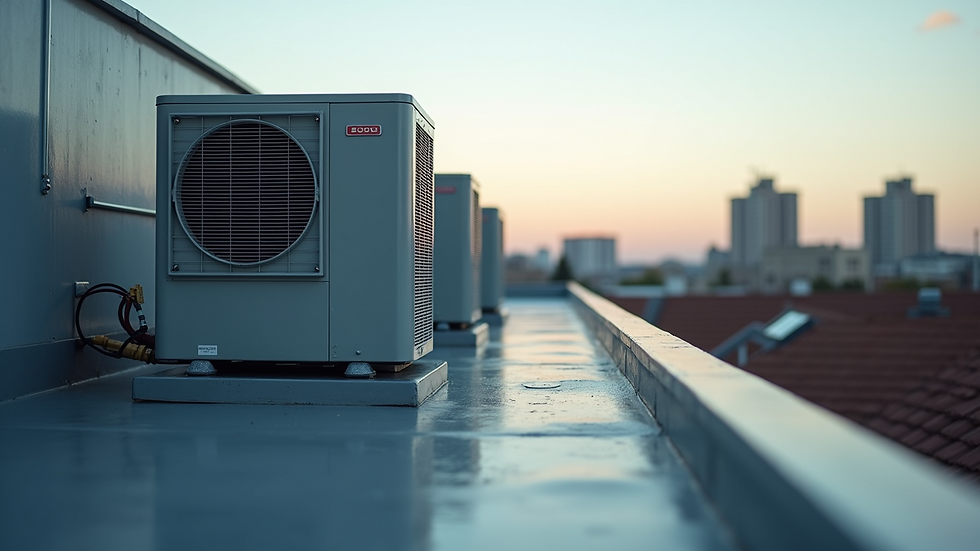Unveiling the Secrets of Portable Air Conditioners: A Comprehensive Guide
- Kirill Anikin
- Jun 12
- 4 min read
As the heat rises, so does the need for a cool sanctuary. Summers can bring sweltering temperatures, making comfort a challenge. Portable air conditioners have surged in popularity due to their convenience and efficiency. This guide is designed to help you understand the ins and outs of portable air conditioning, shedding light on their function, benefits, maintenance, and tips for choosing the right one for your needs.
What is a Portable Air Conditioner?
Portable air conditioners are self-contained cooling units that offer flexibility, allowing users to easily move them from room to room. Unlike traditional central air conditioning systems that are fixed, these compact units are generally mobile and require minimal installation.
A typical portable air conditioner pulls warm air from the room, cools it using a refrigeration cycle, and blows the cooled air back into the space. At the same time, the hot air is expelled outside through a vent. For example, some units can cool a room of up to 500 square feet, making them effective for living rooms or home offices.

Advantages of Portable Air Conditioners
Versatility
One of the standout features of portable air conditioners is their versatility. Whether you're cooling a bedroom during the night or a living room during the day, you can easily move the unit as needed. This is particularly beneficial for apartments where centralized cooling may not be available. For instance, if you're hosting guests in the living room, you can transport the AC unit from your bedroom to ensure everyone stays comfortable.
Easy Installation
Portable AC units are designed for easy installation, often requiring no special tools. Typically, you will only need to attach a hose to your window kit and plug it in. In fact, some models can be ready to use in under 30 minutes. This ease makes them a popular option for both renters and homeowners looking for flexibility in their cooling solutions.
Energy Efficiency
Energy efficiency is a significant advantage of portable air conditioners. Unlike central air systems that cool your entire home, a portable unit allows you to target specific areas. This can translate to savings on your electric bill. For instance, units with Energy Star ratings can save up to 30% more energy compared to non-rated models. Many portable units feature programmable thermostats and timers, maximizing energy usage while working effectively.
Choosing the Right Portable Air Conditioner
Size Matters
The size of your portable air conditioner is critical for effective cooling. Units are rated in British Thermal Units (BTUs), which measure their cooling capacity. A room of 400 square feet typically requires a unit with a BTU rating between 8,000 and 12,000. If the unit is too small, it will struggle to cool your space effectively; if it's too large, it may create excessive humidity and discomfort.
Noise Levels
Portable AC units vary in noise levels. Some models operate quietly enough for a bedroom, while others can disrupt your work. It's essential to check product specifications and read user reviews to find a model that matches your noise tolerance. Units marketed as "quiet" might operate around 50 dB, similar to a gentle conversation, making them ideal for shared spaces or bedrooms.
Ventilation Options
Venting hot air outside is essential for portable air conditioners to function efficiently. Most models come equipped with a window kit, but you should ensure that the kit suits your window style—whether single-hung, double-hung, or sliding. Some units offer ventless options that can work in spaces without appropriate windows, but note that these units may be less effective in cooling compared to conventional models.
Maintenance Tips for Portable Air Conditioners
Regular Cleaning
To maintain efficiency, regular cleaning is crucial. Cleaning or replacing the air filter every month during peak use helps ensure proper airflow and a healthier environment. Additionally, inspect the condensate drain for clogs; depending on humidity levels, frequent draining may be necessary.
Seasonal Storage
Proper seasonal storage is important when the unit is not in use. Thoroughly clean it, ensuring it is dry, and store it in a cool, dry location to prevent mold growth. This simple practice can extend the unit's life and prepare it for the next summer.
Professional Servicing
While portable air conditioners are user-friendly, it's advisable to schedule periodic professional servicing. A technician can check all components and ensure they are functioning properly, potentially extending the lifecycle of your unit.
Embrace Comfort This Summer
Portable air conditioners are transforming how we cope with heat, offering flexibility and efficiency for various spaces. With models tailored for different needs, there’s a perfect unit for everyone. By understanding their functionality, benefits, and maintenance requirements, you can confidently choose a portable AC that keeps you comfortable all summer long.
With the right knowledge in hand, you can navigate the world of portable air conditioners and enhance your indoor comfort. Enjoy a refreshing breeze without the hassle, and make your hottest days feel a bit cooler!





Comments